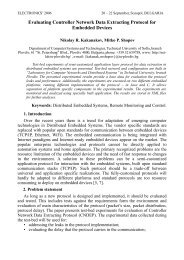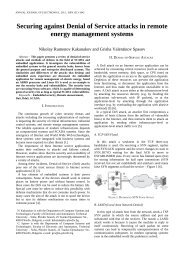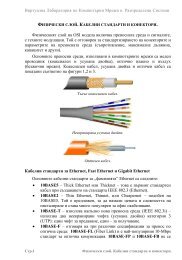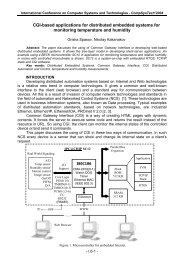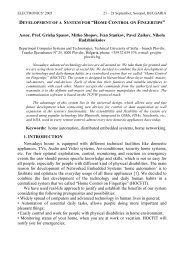SIM300D AT Command Set - Distributed Systems and Networking
SIM300D AT Command Set - Distributed Systems and Networking
SIM300D AT Command Set - Distributed Systems and Networking
You also want an ePaper? Increase the reach of your titles
YUMPU automatically turns print PDFs into web optimized ePapers that Google loves.
<strong>SIM300D</strong> <strong>AT</strong> <strong>Comm<strong>and</strong></strong> <strong>Set</strong><br />
Confidential SIMCOM<br />
<strong>SIM300D</strong>_<strong>AT</strong>_V1.00 Page 81 of 180<br />
string format; BCD numbers (or GSM default alphabet<br />
characters) are converted to characters; type of address<br />
given by <br />
In the case of SMS: GSM 03.40 TP-User-Data in text mode<br />
responses; format:<br />
-if indicates that GSM 03.38 default alphabet is used <strong>and</strong><br />
indicates that GSM 03.40<br />
TP-User-Data-Header-Indication is not set: ME/TA<br />
converts GSM alphabet into current TE character set<br />
according to rules of Annex A<br />
-if indicates that 8-bit or UCS2 data coding scheme is<br />
used, or indicates that GSM 03.40<br />
TP-User-Data-Header-Indication is set: ME/TA converts<br />
each 8-bit octet into two IRA character long hexadecimal<br />
number (e.g. octet with integer value 42 is presented to<br />
TE as two characters 2A (IRA 50 <strong>and</strong> 65))<br />
In the case of CBS: GSM 03.41 CBM Content of Message in<br />
text mode responses; format:<br />
- if indicates that GSM 03.38 default alphabet is used:<br />
ME/TA converts GSM alphabet into current TE character<br />
set according to rules of Annex A<br />
-if indicates that 8-bit or UCS2 data coding scheme is<br />
used: ME/TA converts each 8-bit octet into two IRA<br />
character long hexadecimal number<br />
integer type value indicating in the text mode (+CMGF=1) the<br />
length of the message body (or ) in<br />
characters; or in PDU mode (+CMGF=0), the length of<br />
the actual TP data unit in octets (i.e. the RP layer SMSC<br />
address octets are not counted in the length)<br />
integer type; value in the range of location numbers supported by<br />
the associated memory<br />
GSM 03.40 TP-Originating-Address Address-Value field in<br />
string format; BCD numbers (or GSM default alphabet<br />
characters) are converted to characters; type of address<br />
given by <br />
In the case of SMS: GSM 04.11 SC address followed by GSM<br />
03.40 TPDU in hexadecimal format: ME/TA converts<br />
each octet of TP data unit into two IRA character long<br />
hexadecimal number (e.g. octet with integer value 42 is<br />
presented to TE as two characters 2A (IRA 50 <strong>and</strong> 65)).<br />
In the case of CBS: GSM 03.41 TPDU in hexadecimal<br />
format.<br />
GSM 03.40 TP-Service-Center-Time-Stamp in time-string<br />
format (refer )<br />
GSM 04.11 TP-Destination-Address Type-of-Address octet in



